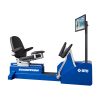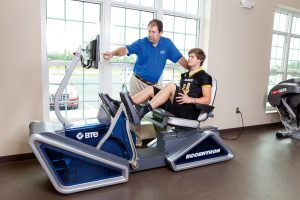
The PT’s Ultimate Guide to Eccentric Training: ACL, Falls Prevention, Neuromuscular Control, and More
Treatment GuidelinesEccentric contractions have so many unique properties that make it ideal for rehabilitation and training. And we’re not just talking musculoskeletal benefits (although this side alone is compelling enough). Eccentrics also engage the neurological system to promote healing, learning, and neuromuscular control, too.
Eccentric training is one of the most powerful and versatile tools in injury recovery, sports training, and functional rehabilitation. Whether you work in geriatrics, neurologic, orthopedic surgery recovery, professional sports, or somewhere in between, eccentric training should be a cornerstone of your physical therapy program.
Eccentric contractions have so many unique properties that make it ideal for rehabilitation and training. And we’re not just talking musculoskeletal benefits (although this side alone is compelling enough). Eccentrics also engage the neurological system to promote healing, learning, and neuromuscular control, too.
The rest of this article will explore each of these aspects of eccentric exercise:
- Eccentric vs concentric
- Lower energy requirement
- Lower oxygen consumption
- Higher muscle loading capacity
- Neuromuscular control and plasticity
- Eccentrics for injury recovery and post-op
- Eccentrics for ACL rehabilitation
- Eccentrics for athletic training: Fast twitch and explosive power
- Eccentrics for falls prevention
- Eccentrics for sarcopenia
- Eccentrics and DOMS
Let’s dive in!
Difference Between Eccentric and Concentric Exercise
Eccentric muscle contraction occurs when the muscle fibers lengthen, as opposed to concentric contractions as the muscle shortens.1 Most movements have both an eccentric and concentric phase, as shown below:


We use both concentric and eccentric contractions in everyday life. Both are necessary for injury recovery, athletic training, and rehabilitation programs of any kind. Traditionally, people tend to focus on the concentric phase of movement during exercise. It can be seen as a more active engagement of the body and it’s usually easier to isolate with typical exercise equipment.
However, underutilizing eccentrics in physical therapy means your patients miss out on a world of benefits, both orthopedic and neuromuscular. Keep reading for a deep dive on why eccentric training is more efficient and effective in both injury recovery and sports training.
Eccentric Training Requires Less Energy
You’ve probably heard this before. But understanding why will show an interesting physiological property that makes eccentrics perfect for rehabilitation. In a nutshell, eccentric contractions use less cellular energy (or ATP) than concentric contractions.2 This is because only the eccentric phase can take advantage of our muscles’ passive ability to store elastic energy.
When a muscle lengthens, energy is stored in the elastic parts of the muscle-tendon unit. During an eccentric contraction, this stored energy is released, reducing the overall metabolic cost. Thus, eccentric contractions are more efficient than concentric.
To better understand, think of an elastic band. When it stretches, it holds potential energy. When you release the band, it easily snaps back or contracts. In our muscles, a similar thing happens when we transition from the eccentric phase to the concentric phase. Following an eccentric contraction, the muscle doesn’t have to work as hard to perform the subsequent concentric action because it’s using or releasing the stored energy.
The key point here is that the muscle can use this reclaimed elastic energy rather than the chemical energy source ATP. Generating ATP requires oxygen and nutrients, which makes it a more “expensive” energy source than elastic energy. The unique usage of elastic energy makes eccentric contractions more efficient. In other words, the muscle can perform the same amount of work using less energy. In fact, the energetic cost of eccentric exercise is about four-times lower than concentric exercise.3
Eccentric Training Requires Lower Oxygen Consumption
Want another physiology lesson? Great! Eccentric exercise uses less oxygen than concentric exercise for the same amount of mechanical work.2 How? Because it uses less ATP. Since generating ATP uses oxygen, using less ATP means using less oxygen. There are two key reasons that eccentric exercise uses less ATP.
First, the use of elastic energy (see above). Storing and releasing elastic energy doesn’t require oxygen, which reduces oxygen demand. Second, less muscle recruitment. Eccentric contractions usually involve fewer active muscle fibers compared to concentric. Fewer active muscle fibers means… less overall oxygen consumption.
Higher Loading Capacity with Eccentrics
Thanks to its unique physiology, eccentric exercise typically allows one to load and tolerate more weight. In other words, muscles are stronger eccentrically than concentrically. This capability comes from several factors:
- Higher force production – Eccentric contractions produce a greater force because the muscle can handle more tension when it’s lengthened, compared to concentric contractions.
- Lower metabolic demand – Uses less energy and oxygen and less muscle fiber recruitment (see above)
- Mechanical advantages – Lengthening under force allows for better force transmission and handling heavier weight
- Reduced perceived exertion – People experience lower perceived exertion compared to concentric work, allowing them to handle heavier loads more comfortably
Eccentric Training Improves Neuromuscular Control and Plasticity
The benefits of eccentric training go beyond muscular strength. Eccentrics enhance neuromuscular control via the motor cortex, which leads to increased neural plasticity and improved task learning. And it does so more effectively than concentric or isometric contractions.4
Eccentric contractions induce higher levels of motor cortex excitability than concentric or isometric contractions. 4 The motor cortex is the part of the brain that generates signals to direct movement of the body. If you work with neurological patients, you know how important this site is to rehabilitation.
With this heightened excitability, the motor cortex more readily sends signals to the muscles. This can improve neuromuscular control, coordination, and neural plasticity. Essentially, this translates to a greater ability to perform and relearn tasks for our physical therapy and occupational therapy patients.
Eccentrics Retrain Neural Pathways to Prevent Reinjury
Recent research into how eccentrics engage neural pathways could change the way apply it in rehabilitation. In a nutshell, the study shows that eccentric exercise improves neuromuscular control to prevent pain and reinjury in a way that concentric exercise does not.5
As we know, injury can lead to guarding postures and compensatory movement even long after recovery. These postural and proprioceptive changes can increase the risk of reinjury, due to neuromuscular control deficits. Lepley’s research aimed to prevent injury by using eccentrics’ unique neuromuscular benefits.
Essentially, the research states that focusing on concentric exercise in rehabilitation encourages the brain to fall into protective, reflexive, tightening proprioceptive patterns. This guarding response prolongs the pain cycle and can lead to incomplete restoration and chronic pain.5
However, eccentrics can break this cycle. According to the research, eccentrics provide a greater neural benefit than concentric or isometric, even in extreme cases like spinal cord injuries.5 In addition, brain activation patterns during the eccentric exercise closely resemble that of a healthy person, which is not true for concentric exercise.
Concentric exercises certainly have their place in rehabilitation. But underutilizing eccentrics could play a part in prolonged or recurring injury. Get a deep dive into this research: How Eccentrics Train Neural Pathways To Prevent Pain, Reinjury.
Eccentric Exercise in Rehabilitation
Now let’s get into what that means for our physical therapy and occupational therapy clients. In the next few sections, we’ll cover the clinical benefits of eccentric training in a few different scenarios. Specifically: injury recovery and post-op, ACL rehabilitation, high-power athletic training, neuromuscular control, falls prevention, and sarcopenia. We’ll also discuss some misconceptions around eccentrics and DOMS.
Eccentric Training in Injury Recovery and Post-op
Let’s start with the most common category for physical therapy and occupational therapy treatment: injury recovery and post-op. Because eccentric training is relatively less fatiguing, it works well for early intervention. Even clients with low tolerance for exercise can benefit from gentle, low-weight eccentric exercise. Eccentric training has proven to singularly benefit several orthopedic conditions.
For example, a clinical review compared 11 treatment techniques for tendinopathy in various parts of the body to find the most effective. These techniques include eccentric-only training, surgery, dry needling, shockwave therapy, PRP injections, corticosteroids, and more. Each treatment provided some level of benefit, but eccentric exercise was the single most effective treatment for all joints in the study.6 In fact, patients with Achilles tendinopathy showed as much as a 94% decrease in pain. 6 Read more about this tendinopathy study here: Research Shows Eccentric Exercise Is Best for Tendinopathy.
Other studies highlight the benefits of eccentric-focused training for these injuries and conditions:
- Hip fracture7
- Total knee arthroplasty (TKA)8
- Spinal cord injury9
- Stroke10
- Parkinson’s11
- Osteoarthritis 12
Each of these orthopedic or neurologic conditions are shown to benefit from eccentric-focused training. Get a summary of these eccentric-focused recovery research studies: Beyond the Basics: Eccentrics’ Versatility in Rehab. Get the special report on eccentric rehab outcomes for OA here: Eccentron Decreases Pain, Increases Strength and Function in Knee Osteoarthritis Patients.
Eccentric Training for ACL Recovery
There’s a reason ACL recovery gets its own section. No two ACL injuries are alike. The patient’s history, the nature of the injury itself, the type of surgical procedure (if applicable), and the activity or sport to which the patient needs to return, all factor into your rehabilitation approach. If you want to dive right in to athlete case studies and clinical research on eccentrics for ACL rehab, check out our e-book: ACL Recovery Unlocked with Eccentric Strengthening and Motor Control.
Download ACL E-book
According to Houston Rockets Assistant Athletic Trainer, Motoki Fuji, sports injuries are more likely to occur during deceleration. Slowing down from a fast pace places significant strain through the lower extremities. If not properly conditioned, this can lead to an ACL injury. With everything we know about eccentrics’ efficiency, safety, and effectiveness at muscle development, it’s become a growing trend in ACL recovery.
One study on ACL rehabilitation techniques showed a 30% strength increase with eccentric exercise, compared to concentric alone.13 The research suggests that eccentric-focused training promotes greater changes in neural activation and muscle hypertrophy. In the training room, that translates to better recovery outcomes and injury prevention.
Eccentric ACL Recovery with Eccentron
If you’re a TherapySpark subscriber, you know we have a long history of promoting an evidence-based approach with eccentric training for ACL recovery. Specifically, BTE’s Eccentron is the only resistance trainer that leverages those unique physiological and neurological benefits by isolating only eccentric contractions.
While Eccentron is clinically proven to benefit many orthopedic injuries, ACL recovery gained particular attention in recent years. This is due to its importance to professional and collegiate sports, and the challenging nature of ACL rehabilitation in general. Learn how University of Georgia’s Athletic Director dramatically reduced recovery timelines with his three-part ACL rehab strategy: Ron Courson’s Game-Changing ACL Techniques.
Third-party-published research shows dramatic improvement in muscle activation, size, and strength, and athletic performance following ACL injuries. Compared to traditional rehabilitation programs, eccentric-focused training with the Eccentron provides several outstanding results:
- Four-times higher muscle activation in the quadriceps, gastrocnemius, hip adductors, and hamstring during exercise6
- 17% higher increase in quadriceps size following 12-week training, compared to standard training14
- Achieving pre-op levels of strength and hopping at three months post-op, versus the standard group achieving these levels nine months later14
- 8% higher vertical jumps following six-week training, compared to standard training15
- More than 50% greater increase in quadriceps and gluteus maximus muscle volume at one-year follow up, compared to standard training16
- 29% greater increase in hopping distance at one-year follow up, compared to standard training group16
Eccentric training is ideal for ACL recovery because it’s less demanding on the body while still promoting muscle size and strength. Athletes in particular can benefit from the neuromuscular advantages of eccentric training. Designing eccentric-focused exercises that mimic the athlete’s sport movements helps retrain their body and brain.
Eccentrics for Athletic Training: Fast Twitch Muscle and Explosive Power
Eccentric training can help your athletes get back in the game and optimize their athletic performance. Eccentric-focused training results in greater strength gains than concentric or traditional training.17 More specifically, eccentrics promote greater growth of fast-twitch or type II muscle fibers. 17 These muscles engage in explosive, high-intensity activities. Fast-twitch muscle fibers have a high force-generating capacity during eccentric contractions, which can lead to significant gains in overall muscle strength and power.
Athletes who need quick, explosive power can build strength more efficiently with eccentrics. Sports like track and field, weightlifting, gymnastics, football, soccer, basketball, and baseball require repeated bursts of explosive power. These athletes can improve their quick, explosive action by building fast-twitch muscle with eccentric training.
Eccentrics in Professional Sports: NBA, NFL Optimize Training with Eccentron
In professional sports training, efficiency is key. Eccentric-focused training is the most efficient approach to injury recovery and strength training. The Houston Rockets’ Assistant Athletic Trainer, Motoki Fuji, explains the importance of eccentric training for both injury prevention and athletic performance.
“The eccentric component is huge for NBA players because they’re so explosive. [In basketball] many injuries occur in the eccentric phase during deceleration, so the Eccentron is for both performance and injury reduction.” – Motoki Fuji, ATC. Assistant Athletic Trainer, Houston Rockets
The Houston Rockets use the Eccentron to prevent injury and optimize their players’ performance. With its high capacity for eccentric-only loading and unique motor control training, it has become essential to the team. Read more about how the Houston Rockets prevent injury and build strength with Eccentron here: Inside the NBA Bubble: Eccentron Is Essential to Players’ Performance.
Eccentric-only training has brought other sports teams to the next level. The Baltimore Orioles, Buffalo Bills, and New York Knicks also train and rehabilitate their athletes with Eccentron. Plus, a handful of professional players use Eccentron at home during the offseason to maximize their training year-round. A few of Eccentron’s most notable success stories include Dwight Howard and Todd Gurley. Check out Gurley’s recovery story below:
Eccentric Exercise for Falls Prevention
According to CDC data, fall-related deaths increased by 30%.18 Fall risk is a major concern for Physical Therapists or Occupational Therapists working with older adults. Thankfully, preventive rehabilitation can help reverse the trend and prevent falls. Eccentric exercise demands less oxygen and energy, making it ideal for elderly clients. Even if they have a low tolerance for exercise, older adults can engage and strengthen the lower extremities with eccentric-focused training.
Eccentric training is not only safe enough for seniors, it is actually more effective at reducing fall risk. According to research, eccentric-only exercise reduced fall risk significantly for older adults, more than traditional exercise.19 This study compared two groups of older adults – one performing eccentric-only exercise on Eccentron and the other performing traditional exercise. As a result, only the eccentric group significantly reduced their fall risk, moving from high risk to low risk in a timed up and go test.19
In a falls prevention rehabilitation program, it’s important to dose the right amount of resistance and increase gradually. With the Eccentron, you can load as little as a fraction of the client’s bodyweight. That makes it safe for even your most frail seniors. Using the lowest resistance on the Eccentron simulates the movement of walking down the stairs. But with the resistance below the client’s bodyweight, it becomes an unweighted stair descent. This closed-chain, eccentric-only exercise is gentle enough for early post-op and severely deconditioned clients.
Sarcopenia Prevention with Eccentric Exercise
Earlier in this article, we discussed how fast-twitch muscle enhances explosive power for athletic performance. In addition to athletics, fast-twitch or type II muscle development also applies to sarcopenia, or age-related muscle loss. Studies show that type II muscle atrophy is the primary contributor to sarcopenia, more than other muscle fiber types.20,21
Type II muscles provide function and safety in most daily activities. As our elderly clients face sarcopenia, their risks of injury, falls, and loss of function, mobility, and quality of life increase. Thankfully, Physical Therapists and Occupational Therapists can build those muscle fibers to protect elderly clients. Studies show that eccentric exercise can prevent and even reverse age-related muscle loss.15 Elderly patients can regain muscle mass and function as their fast-twitch muscles develop.
According to research, eccentric exercise results in greater strength gains and improved functional performance in seniors with sarcopenia.19 The study compared two exercise groups: one performing traditional rehabilitation exercises and one exclusively eccentric training with Eccentron. Both groups had significant gains in muscle fiber cross-sectional area. However, only the eccentric group showed significant improvement in strength (60%), balance (7%), and stair descent (21%). All eccentric participants reported the exercise as “relatively effortless” with minimal soreness.19
This study demonstrates the power of eccentric-only training for elderly clients in physical therapy or occupational therapy programs. Despite having low exercise tolerance, seniors with sarcopenia can increase muscle mass and function more effectively with eccentric exercise. With low energy requirement, eccentric-only training is gentle yet effective for elderly or injured clients.
Eccentrics and DOMs
No discussion of eccentric exercise would be complete without addressing DOMS, delayed-onset muscle soreness. Some of the physiological factors that make eccentrics so effective are also the reason it can cause DOMS. Factors like fewer muscle fibers being recruited, stress under lengthening, microtears, and stress on connective tissue contribute to soreness. However, a couple of nuances are worth discussing here.
First, it’s easy to overdo it with eccentrics. Because we can tolerate higher loads with less fatigue, people tend to exceed their normal exercise capacity. They’ll frequently add more weight, do more reps, and combine eccentrics with concentric work. In this case, it’s the total volume of exercise that leads to greater soreness. This mainly applies to self-directed workouts, rather than rehabilitation sessions.
Second, DOMS means the body is being challenged. New or more intense exercise is necessary for adaptation and growth. Eccentric exercise is known to produce greater strength gains. Regular eccentric training can lead to long-term improvement in function, force production, neuromuscular control, and coordination. Over time, it can help condition muscles and tendons to be more resilient.
Ultimately, the benefits of eccentric exercise outweigh the temporary discomfort of DOMS. To recap some of these unique benefits for rehabilitation:
- Lower energy and oxygen requirements
- Lower perceived fatigue
- Greater gains in muscle size and strength
- Improved neuromuscular control and plasticity
- Development of fast-twitch / type II muscle fiber
- Reduction of fall risk
- Research-proven benefits for tendinopathy, hip fracture, TKA, spinal cord injury, stroke, Parkinson’s, ACL injury, and sarcopenia
Eccentric Rehabilitation for Your Physical Therapy Clinic: Eccentron by BTE
Exercise scientists have known for decades that eccentric exercise is the most efficient and effective way to build muscle, strengthen joints, and promote neuromuscular control. But that knowledge didn’t disseminate into physical rehabilitation practices until much later. In order to maximize exercise’s unique capabilities, we needed a way to isolate the eccentric phase of movement. How can you facilitate an exercise with ONLY eccentric contractions and zero concentric force? That’s exactly what we asked ourselves when we created the Eccentron.
The Eccentron is an eccentric-only, closed-chain, lower extremity training device. It’s like a recumbent stepper, but the opposite mechanism. Instead of pushing, the patient resists with eccentric movement. Motorized foot pedals move towards the patient as they engage eccentric resistance against the pedals. Meanwhile, the screen provides a visual target with real-time force feedback, training the patient’s motor control and force control. And patients love using it.
Scott Romanowski, Director of Vereen Rehabilitation, keeps patients engaged with Eccentron for athletic training and injury recovery. Read the full case study on Eccentron for athletic performance and injury recovery here: Vereen Rehabilitation Drives Revenue and Gets Patients Better, Faster.
“Once patients try the Eccentron, they get hooked. Patients love the interactive game experience, and are motivated by their visible progress to keep coming back for more sessions, getting stronger and returning to function.” – Scott Romanowski, PT, OCS, OMPT
Marla Tappy, owner of Momentum Sports Medicine and Wellness, praises its versatility for a wide range of patients, from athletic to geriatric. Marla says the Eccentron is the perfect tool for both lower extremity orthopedic injuries and neurological challenges such as Parkinson’s or multiple sclerosis.
“Because we live in a sparsely populated area, we need to serve everyone. This equipment works for all these different populations and is the centerpiece in the gym. The versatility allows for a quick, yet subtle transition from passive range of motion to progressive eccentric strengthening.”- Marla Tappy, MS, PT, ATC
It’s not just her patients that love it. Referrers notice impressive results as well. Tappy shares, “I received a call last week from an orthopedic surgeon who just completed a three-week postoperative visit on a 44-year-old patient of mine following bilateral total knee replacements. He said, ‘My patient has full range of motion and a normal gait pattern. What are you doing out there?’ I told him ‘It’s Eccentron.’” Get the full case study on Tappy’s success in a rural cash-based clinic here: Momentum Sports Medicine Case Study.
The Eccentron is an extremely versatile trainer that keeps patients engaged while building strength and neuromuscular control. But you don’t have to take our word for it. A number of third-party clinical research teams have put Eccentron to the test, completely independent of BTE. Explore the body of research supporting Eccentron as an evidence-based practice in physical therapy, athletic training, and occupational therapy.
Download Now
Conclusion
As you can see, there is a ton of clinical evidence supporting eccentric training in physical therapy. The physiology behind its effectiveness and efficiency is well-documented in the scientific community. However, translating that knowledge into everyday practice for sports injuries, orthopedic and neurologic rehabilitation, and athletic training takes careful consideration. Each patient has unique needs, goals, and capabilities. With some creative thinking, you can find ways to emphasize eccentric contractions in your physical therapy program. With clinical research on orthopedic injury and surgery, neurological rehab, falls prevention, and athletic performance, eccentric training is extremely versatile.
At BTE, we promote evidence-based treatment with our physical therapy equipment like the Eccentron. With the Eccentron, you tap into all the musculoskeletal and neurological benefits of eccentric training. Appropriate for geriatrics to athletics, it’s one device that delivers engaging, research-proven treatment for your whole practice. Plus the automated objective progress reports make it easy to track and share progress with patients and referrers. Interested in the Eccentron for your practice? Get a quote today: BTE Sales.
Didn’t get enough eccentrics content? Check out our other resources on eccentric training for rehabilitation and athletic performance:
- Everything You Need To Know About Eccentrics: Webinar on Demand
- Ron Courson on The Powers of Eccentric Training in ACL Rehab
- CPM with Target Force and Eccentrics with BTE PrimusRS
- COVID-19 Rehab: Eccentric Balance and Walking with PrimusRS
- Eccentric Physical Therapy for Cardiorespiratory / COVID-19 Recovery





